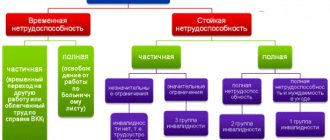Concept
An effective contract is a type of employment contract that regulates the amount of bonus payments depending on the volume of work and the quality of services provided, and also specifies as much as possible the essential aspects of the agreement.
These aspects include: the conditions for remuneration, the employee’s job responsibilities, as well as the indicators and criteria necessary for the correct assessment of work results.
Functions of an effective employment contract:
- Assignment of a state task.
- Regulation of performance indicators requested by the founder.
- Establishment of a system for assessing the labor efficiency of employees of a given enterprise.
- Regulating indicators of the volume of work and its quality for a specific employee.
- Regulation of wages taking into account the specifics of the activity.
- Standardization of the nature and volume of work of enterprise employees.
- A detailed description of the work responsibilities of an individual, taking into account his professional specifics and field of activity.
How to develop a sample of an effective contract
When formalizing labor relations with employees, it is recommended to take into account regulations (and, if not available, develop them) that define:
- wage system (including official salaries, wage rates, additional payments, allowances);
- labor standardization system;
- working conditions based on the results of a special assessment of working conditions;
- working hours and rest hours;
- staffing of the institution;
- conditions that determine, in necessary cases, the nature of the work (mobile, traveling, on the road, other nature of work).
The main challenge in introducing an effective contract relates to the development of measurable performance indicators. These indicators must be carefully thought out and tested. It is necessary to build a unified system of requirements for employees, arising from the requirements for the activities of the institution itself, provided for in state and municipal assignments and other similar documents.
Without this condition, an effective employment contract will simply remain a longer employment agreement.
How are they different from each other?
| Effective contract | Employment contract |
| May be an agreement between the manager and the founder | Concluded between employer and employee |
| Labor activity is as specific as possible | Contains general information about the labor function |
| Payments taking into account the specifics of the work and the quality of the task performed | Payment upon completion of work |
| Concluded in accordance with Decree of the Government of the Russian Federation dated April 12, 2013 N 329 “On the standard form of an employment contract with the head of a state (municipal) institution” | In a general form, indicating the aspects reflected in Art. 57 Labor Code of the Russian Federation |
A distinctive feature of an effective contract is the mandatory display of the conditions for receiving social assistance and making bonus payments in order to stimulate labor, as well as:
- Name and type of cash payment.
- Conditions of receipt.
- Target criteria and performance assessment indicators.
- Periodicity.
- Volume of payment.
Thus, the term “indicators and criteria for assessing performance efficiency” mentioned in the content of the employment contract will be a determining factor in the transition to an effective contract. When determining the criteria, first of all, it is necessary to rely on the methodological recommendations in the letter of the Ministry of Education and Science of Russia dated June 20, 2013 No. AP-1073/02 “On the development of performance indicators.”
The difference between an effective employment contract and a regular one
In addition to the name, there are regulatory differences between an employment contract and an effective contract:
- An effective contract clearly formulates the functions that an employee occupying a particular position must perform in the organization; it specifies how to evaluate effectiveness, what results need to be achieved in a particular position, and what standards need to be implemented.
- An effective contract prescribes a system of incentive payments, that is, it indicates how much work must be completed in order for the employee to count on an increase or bonus.
A separate clause of the contract is employee incentives: the name of the payment, its frequency, the conditions for receiving it, the criteria for evaluating the employee, as well as the amount of material (or other) remuneration are indicated here.
In general, in many points the differences can be found only in the wording, but an effective contract is more detailed and clear.
Content and structure
An approximate form of such a business paper includes:
- City, locality of the institution.
- Document creation date.
- Full name of the enterprise.
- FULL NAME. leader.
- Confirmation of rights (power of attorney).
- FULL NAME. employee.
The first part contains general provisions:
- A specific person is given the opportunity to engage in activities in ... (position and specialty are indicated).
- The employee undertakes to personally perform the tasks assigned in accordance with the terms of this employment contract... (the types of work to be performed are indicated).
- Full name of the organization and legal address.
- The address of the department in which a specific person is hired.
- Type of work (main or part-time).
- Duration of the contract, indicating the reasons for its conclusion (if appropriate).
- The effective date of the business document.
- Work start date.
The following parts show:
- Responsibility and rights of the employee.
- Rights and obligations of the employer.
- Terms of remuneration.
- Working/rest time.
- Other terms of the employment contract (for example, non-disclosure of official secrets).
- Responsibility of the parties to the employment contract.
- Reasons for changing and terminating a contract.
- Final provisions.
- Signatures of the employer and employee (on two different copies).
Important! A mandatory item in the form of an effective contract is social support for the worker.
Advantages and disadvantages
Using effective contracts has important advantages:
- Employees see how their performance is assessed and can receive payments in accordance with the results they achieve. For more intensive work, the employee receives higher pay.
- If employees achieve excellent results, they can count on receiving a bonus.
- Additional payment is made for the existing level of qualifications.
- Employees see what results are rewarded for and are interested in improving their work.
- The developed incentive system takes into account the specifics of the activities of a particular institution when developing an incentive system.
The disadvantage of this type of contract is the insufficient development of the provisions on which they are based. Sometimes the proposed reward system is not effective enough.
Procedure for transferring an employee
The procedure for changing contract data is regulated by Article 74 of the Labor Code of the Russian Federation and can only be performed with mutual agreement of the parties; The cases described below also rely on this statement:
- Unilaterally - the employer has the right to adjust the contract in connection with a significant restructuring of the enterprise and the actual impossibility of continuing cooperation under the given conditions. In this case, it is necessary to notify the employee (at least two months in advance), inform about the reasons for the changes and offer an alternative that matches his professional skills. If a refusal is received, the employment agreement is terminated (clause 1, part 1, article 77 of the Labor Code of the Russian Federation).
- By agreement of the parties - in accordance with Art. 72 of the Labor Code of the Russian Federation, an employee has the right to submit an application, drawn up according to the general procedure for filling out business papers, addressed to the manager with a request to adjust the contract, indicating the reasons, nature and timing of the expected execution. If the answer is positive, an additional agreement to the main document is signed.
- For all employees - without affecting the labor function, upon provision of evidence that the organization has undergone significant organizational and technological modernization.
- For one employee - in accordance with the general procedure specified in paragraph 1.
What is a contract in procurement?
the state is one of the parties . It may operate through authorities or certain types of organizations. To meet the needs of the state, procurement is carried out in accordance with law 44-FZ. Within the framework of this norm, contracts are concluded between the customer and the contractor. In this case, the executor can be any person who meets certain requirements, both legal and physical. But the second party to contracts is always the state, that is:
- public authority;
- state corporation;
- state-financed organization;
- government agency;
- state or municipal unitary enterprise.
In other words, the contract is concluded with budget money . The customer declares his needs, the contractor satisfies them and receives payment for this from the budget of the appropriate level.
How to correctly draw up an additional transfer agreement?
Such a paper begins with the words “agreement on a new version of the employment contract” and contains:
- Document number according to the procedure of office work.
- Place of creation.
- Date of creation.
- Grounds for restructuring an employment contract with reference to legislative acts.
- FULL NAME. employee.
- FULL NAME. employer.
- The employer's position as confirmation of the right to adjust the contract.
- Date of entry into force of the new edition.
- A note about the loss of legal force of the previous version of the agreement.
- Worker visa.
- Employer visa.
- A note indicating that the employee received the copy.
When hiring an employee, a formal contract should always be drawn up, of which there are different types. We invite you to read about urgent labor agreements, as well as how an employment contract differs from a civil law, labor agreement and work contract.
Stages of transition to a new agreement
The procedure for implementing the use of an effective contract occurs in several steps:
- The boss issues an order that it is planned to introduce the use of the type of contracts in question in the institution.
- It is necessary to organize a group of employees whose responsibilities will include the implementation of a new type of contract.
- An analysis of the documentation available in the organization is carried out for compliance with the Program and other regulatory documents in this area.
- The development of used performance indicators in relation to each employee is being carried out. It is important to note that such work occurs constantly, and does not end at some point in time.
- Based on the training provided, a form of an effective employment contract is developed.
- The provisions of the organization’s internal documents are being adjusted. Changes necessary for the implementation of new labor agreements are made to job descriptions, taken into account in the Regulations on remuneration, and reflected in the collective agreement.
- Once the necessary documents have been prepared, employees are notified of upcoming changes.
- In the manner prescribed by law, additional agreements to employment contracts are signed.
With new employees, an effective employment contract is signed upon joining.
It is important to note that the development of new performance criteria should be carried out on objective grounds. If the rights of workers are threatened, they can file a lawsuit against the organization to protect themselves.
Termination procedure
This procedure can be carried out at the initiative of the employer in accordance with clause 13 of Article 81 of the Labor Code of the Russian Federation: in cases provided for in the employment contract with the head of the organization, members of the collegial executive body of the organization. This is in addition to the possibility of dismissing the head of an organization without guilt and without explanation based on the decision of the founder (Article 278 of the Labor Code of the Russian Federation).
Any significant change to the employment contract requires careful consideration by the employer. Even minor adjustments can lead to tangible reforms to employment conditions. A clear understanding of the legislative and practical aspects of the issue is necessary. Thus, one should always consider how changes will affect both the employee and the overall health of the organization.
If you find an error, please select a piece of text and press Ctrl+Enter.
The functionality of such a document
The transition to a new contract is intended to solve several problems at once and perform several functions:
- a general increase in the efficiency of the economy - if each specific employee fulfills his duties in accordance with the contract, which states what, in what time frame, and for what remuneration he must do, then the fulfillment of assigned tasks will be increased, and therefore the overall economic situation will be improved.
Quality control - the employee must understand what he receives money for and what he will not receive anything for; in the same way, the employer must understand in which case he will have to pay more and when he can pay less.
All norms are prescribed in the contract, and neither party can have questions about “where did this amount come from.” Increasing collective performance - this function is of no small importance in large enterprises, because the success of a common cause depends both on the contribution of each person and on the overall cohesion of the team.







